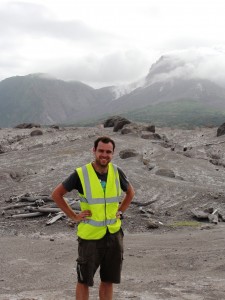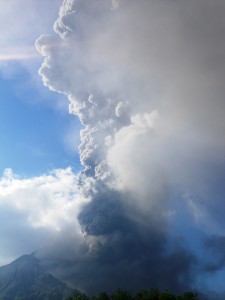I was recently lucky enough to spend some time in Japan as part of a scientific conference in the southern-most tip of Kyushu along with my colleague Sebastian Watt. The conference was called IAVCEI, and is the ‘world cup’ of volcanology meetings, as these international gatherings only occur every 4 years. This was my first time to Asia, and Japan did not disappoint. The streets were clean, everything ran on time and the people were so nice, despite my lack of language skills. The conference was based in Kagoshima, a small city likened to Naples because of its proximity to a large volcano across the bay. However unlike Naples there is very little crime in this tranquil city and the volcano, 8 km from the city (Sakurajima), is a lot more active than Vesuvius. Evidence of this was pretty clear on the outset based on the presence of thick piles of black volcanic sand in the streets, a constant reminder that this volcano must have a large impact on the region. Even during the ice-breaker we were treated to some Vulcanian explosions of ash and gas rising over a kilometre into the sky- and I was just expecting some cheap beer and nibbles!
I was particularly excited about this conference as I had submitted an abstract for an oral presentation, in which the title was a pun… ‘Cores for concern: The difficulty of recording tephra fallout deposits in marine sediments’. I was in luck – the convenors had a sense of humour and granted me a talk! The talk was based around my PhD and post-doctoral research which focusses on constructing records of volcanic activity, based on marine sediment cores. Marine cores are becoming increasing used to work out periodicity of volcanic eruptions and as a tephrochronological tool, because volcanic deposits on land are often unexposed, difficult to access and either buried or eroded by subsequent deposits. Nevertheless there are still problems with interpreting marine volcanic deposits, hence the title of my talk, but knowing how to account or even solve these will be of key importance for this area of marine geology. I also presented a poster about upcoming work in Southampton, in which Sebastian and I will aim to understand how large landslides offshore Montserrat (a volcanic island in the Caribbean) can affect the plumbing systems of the volcanoes on the island.

In the middle of the conference we were treated to a little fieldtrip around the volcano and as soon as we arrived at the closest viewpoint from the volcano, only 3.5 km away, Sakurajima put on a great show (see photo). I have been fortunate to see several volcanic eruptions in Mexico, Iceland, Chile and Italy, but this was largest I had seen, and featured phenomena such as decompression waves, volcanic lightning and loud roaring noises- quite spectacular. I knew that the Japanese were known for their organisational skills, but getting a volcano to erupt on demand was taking it to a new level! Overall a great experience and many interesting talks and posters which I still need to digest – (as well as the raw fish).

Mike Cassidy is doing a post-doc at in Volcanology at the University of Southampton, but he has recently paused this to carry out a short research post at the University of Plymouth on volcanic monitoring.